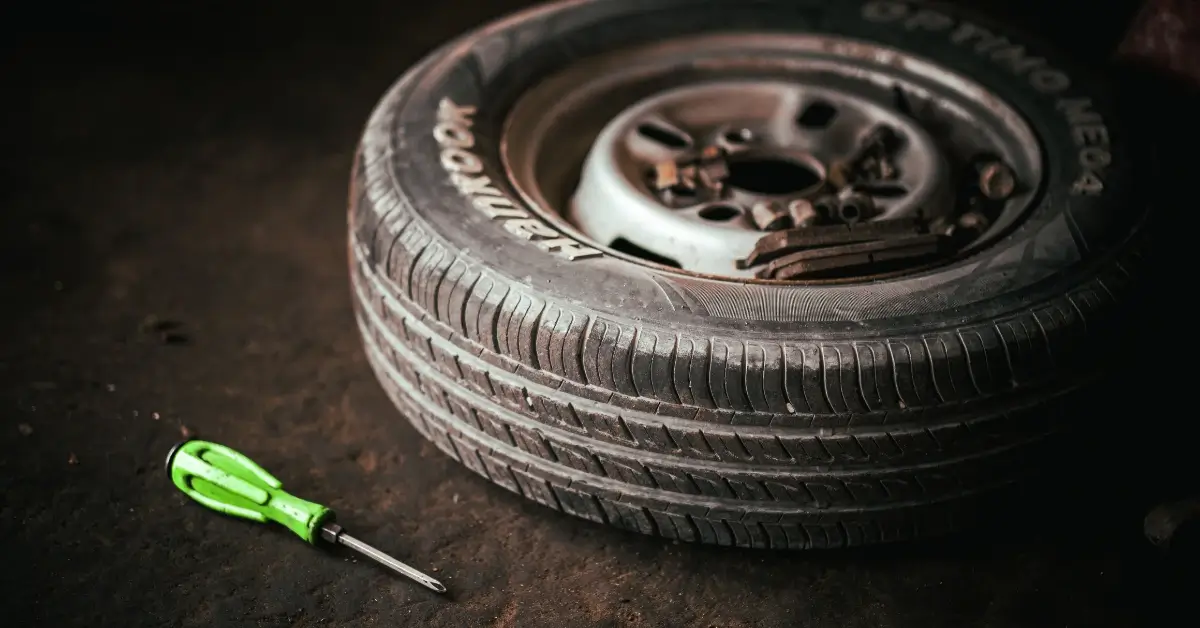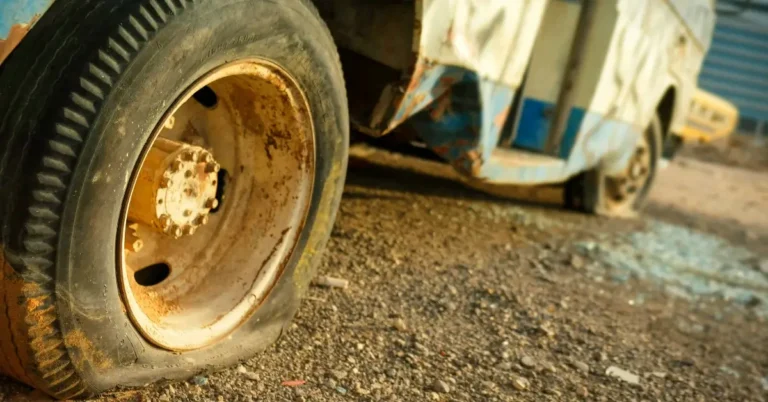When we’re out on the road, it’s always smart to be prepared for the unexpected, like a flat tire. With a car tire patch kit in your trunk, you have a quick and reliable solution. These handy kits equip us to tackle punctures and small leaks on our own, avoiding waiting time for roadside assistance or a tow to the nearest garage.
Our tires are the only connection to the road, and their care shouldn’t be overlooked. Regular maintenance checks are essential, but the truth is, we can’t always avoid accidents. Whether we’re commuting to work or on a road trip, a car tire patch kit can save the day, getting us back on track in nearly no time. Plus, learning to use one is easier than we might think, adding an invaluable skill to our ever-growing do-it-yourself repertoire.

Essentials of a Car Tire Patch Kit
When we’re facing a flat tire, having a reliable car tire patch kit is a lifesaver. Let’s explore what essentials should be in your kit to get you back on the road.
Patch Types
- Plugs: Ideal for sealing punctures in the tread area, plugs are quick fixes but not permanent solutions.
- Patches: More durable than plugs, these adhere to the inside of the tire and are considered a more permanent fix.
The choice between a tire plug and a tire patch often depends on the nature of the tire damage. While plugging a tire is a straightforward process, patching might be the better option for long-term repair, especially if the puncture is larger or on the tire’s tread.
Tools Included
- T-handle Insertion Tool: Essential for inserting plugs into a punctured tire.
- T-handle Spiral Probe Tool: Use this to clean and prepare the hole for repair.
- Sealant: A special adhesive that secures the patch to the tire.
- Lubricant: Eases the plug insert process.
The tools in your car tire patch kit should be robust and capable of handling the tough rubber of a tire. A good car tire repair kit usually includes effective instruments, such as T-handle insertion and probe tools, which allow for easier manipulation of the patch or plug. It’s important that we also have the necessary sealant or lubricant to facilitate the repair process.
Step-by-Step Patching Guide
When we face a tire puncture, it’s crucial to have a car tire patch kit handy. Here’s how we tackle the repair.
Preparing the Tire
First, identify the puncture location. We’ll need to clean the area around the puncture using a wire brush, ensuring it’s free from dirt and debris. Sometimes we might need to slightly deflate the tire to remove any foreign objects stuck in it.
- Remove: Take out the object that caused the puncture with pliers.
- Clean: Brush the area surrounding the puncture to clear debris.
- Mark: Circle the puncture site so it’s easily visible during the patching process.
Applying the Patch
Once the area is prepped, we need to roughen up the surface around the puncture using a rasp tool. This helps the patch adhere properly. Next, apply a generous layer of vulcanizing glue and wait for it to become tacky before placing the patch over the puncture.
- Scuff: Roughen the area with a rasp tool.
- Glue: Apply vulcanizing glue and let it set until tacky.
- Patch: Center the patch over the puncture and press down firmly.
Finishing up
For the patch to be set securely, we must apply pressure for a solid bond. Finally, we’ll reinflate the tire to the recommended pressure and inspect for any leaks. If all is well, we’re ready to remount the tire.
- Seal: Use a roller to press down the patch firmly.
- Inflate: Return the tire to its proper pressure.
- Test: Check for leaks and remount the tire.

Selecting the Right Patch Kit
When we’re facing a flat tire, having the right car tire patch kit is essential. It can get us back on the road quickly and safely. Here’s what you need to know to make the best choice.
Kit Varieties
There are several types of car tire patch kits available, each suited for different situations. For standard passenger vehicles, basic kits typically include tire patches, glue, and tools for insertion. For more rigorous conditions, like off-roading, a more robust kit with a variety of patches and heavy-duty tools might be necessary.
Quality Considerations
The durability of a car tire patch kit hinges on the quality of the materials used. Look for thick, adhesive-backed patches that can withstand high pressure. It’s also crucial to have strong, ergonomic tools that can handle the force required to install the patch.
Brand Comparisons
It’s worth comparing brands to find the best kit. The Rhino USA 86-Piece Tire Repair Kit is praised for its comprehensiveness, making it a top contender for best overall. For those on a budget, Slime Tire Repair offers an affordable, yet effective option. Meanwhile, Boulder Tools provides a highly regarded compact tire repair kit that’s easy to carry.
Safety Measures and Precautions
When you need to repair a flat tire with a car tire patch kit, safety is paramount for us. By following these guidelines, we can ensure a secure repair process and minimize risks.
Handling Tools Safely
- Inspect Tools Before Use: Before we begin any tire repair, it’s crucial to inspect our tools for damage. Using damaged tools can lead to improper repairs or personal injury.
- Wear Protective Gear: Always wear safety gloves and eye protection. This will protect our hands from sharp objects and our eyes from any debris.
Post-Patching Checks
- Check for Air Leaks: After applying a patch, we need to ensure that there are no air leaks. This can be done by listening for hissing sounds or using soapy water to check for bubbles.
- Test Drive Slowly: Once the patch is in place and the tire is remounted, we should take a slow test drive. This allows us to confirm the repair has been done and the vehicle is handling properly.

Troubleshooting Common Issues
When using a car tire patch kit, you might encounter a couple of hitches along the way. We’re here to guide you through two common problems: adhesive failures and patch misalignment.
Adhesive Failures
Adhesive failures can be particularly frustrating. They usually occur when the patch doesn’t stick to the tire as it should. This could be due to a variety of factors such as a dirty puncture area, improper use of adhesive, or outdated patch material. To ensure success, make sure the tire’s surface is clean and free of debris before applying the patch. Also, check the expiration date of the adhesive—if it’s past its prime, it won’t work effectively.
Patch Misalignment
Another issue is patch misalignment. For the patch to work, it must be centered and firmly pressed over the puncture. Misalignment can cause air to escape, thus failing to seal the puncture properly. It’s essential to align the patch accurately with the hole. Once it’s in place, apply even pressure to form a strong bond. Remember, a well-aligned patch is key to getting back on the road with confidence.
Maintenance Tips for Tire Longevity
We all want our trusty car tire patch kit to be in tip-top shape when we need it most. To ensure its reliability, there are essential maintenance steps we should follow.
Regular Inspection
It’s crucial to inspect your kit periodically for any missing or damaged tools. A fully stocked and operational kit is vital for fixing a flat tire effectively. Look for any wear and tear on the tools and validate the expiration dates of sealing compounds if included.
- Make sure the tire plugs and patches have not degraded over time. These are the key components that will help you seal punctures in your tires.
Proper Storage of the Kit
The place where you keep your Car tire patch kit can impact its condition. Store it in a cool, dry place out of direct sunlight to prevent any materials from deteriorating.
- An organized kit ensures everything is easy to find in an emergency. Use containers or pouches to keep the tools and materials sorted and ready for use.
Cost Analysis
When considering a car tire patch kit, we’re often faced with the choice between rolling up our sleeves to do it ourselves or heading to the pros for repair. Each option has different costs associated, and it’s important to understand the value that a kit can bring over its lifetime.
DIY Patching vs. Professional Repair
DIY Patching Costs
- Initial cost of a car tire patch kit: $5 to $30
- Tools required for installation (if not included in the kit): $10 to $50
Professional Repair Costs
- Average tire patching service: $10 to $30
- Specialty tire repairs: $20 to $60
While a DIY tire patching might seem more economical at first glance, remember that some tires may require special attention that only professional repair services can offer.

Lifetime Value of a Kit
Owning a car tire patch kit means you’re set for multiple puncture incidents. Considering an average kit can be used for at least five repairs, the costs break down as follows:
- Per use cost: If a kit is $20 and it’s used for five repairs, that’s effective $4 per patch.
- Savings over time: Compared with professional costs, you potentially save at least $6 per repair, totaling a minimum of $30 in savings across the kit’s lifetime.
Having a car tire patch kit in your trunk is not about savings; it’s about the convenience and peace of mind of being prepared for those unexpected punctures.
User Reviews and Recommendations
When considering a car tire patch kit, it’s essential to look at user reviews and recommendations, as these often offer real-world insights into the kit’s effectiveness for different vehicle types and the overall satisfaction provided to customers. I really like to do that on different platforms to get as many reviews as possible.
Best Patch Kit for Different Vehicles
We’ve noticed that certain tire patch kits come highly recommended for specific types of vehicles. For example, heavy-duty trucks may benefit from a kit that includes a broader range of plug sizes and more robust tools. Motorcyclists, on the other hand, often prefer a more compact kit that’s easier to carry. One example is the Rhino USA 86 Piece Tire Repair Kit, which is frequently mentioned positively across various vehicle categories.
- Sedans and Small Cars: Lightweight, space-saving kits are preferable.
- SUVs and Trucks: Look for kits with a variety of plug sizes and durable tools.
- Motorcycles: Compact kits that fit easily in under-seat storage are ideal.
Customer Satisfaction Ratings
Customer satisfaction ratings are a crucial aspect to consider. These ratings can provide us with a more comprehensive understanding of a product’s reliability and ease of use. Following the best rated kits:
- Rhino USA 86 Piece Tire Repair Kit: Customers praise its comprehensive set of tools and durability.
- Boulder Tools Tire Repair Kit: Known for its heavy-duty construction, suitable for trucks and SUVs.
Average-Rated Kits:
| Brand | Rating | Pros | Cons |
|---|---|---|---|
| Tooluxe 35-Piece Set | 3.5/5 | Affordable | Less durable |
| BETOOLL 22-Piece Tire | 4/5 | Compact | Fewer tools |
Users often share feedback that a car tire patch kit with clear instructions and reliable components makes the repair process quicker and less stressful, which is a common theme across the best-reviewed kits.
FAQ
Do car tire patch kits work?
A properly installed patch will do a great job of allowing the tire to hold air. However, similarly to the plug-only repair, the patch does not fill the injury channel. Therefore, air and moisture could seep into the tire from the tread surface and eventually damage the tire.
Can you patch your own car tire?
The only way to properly repair a tire is to demount it from the rim so it can be inspected on the inside, remove the damaged material, fill the void with rubber, and seal the inner liner with a repair unit.
Is it smart to leave a screw or patch the tire?
Originally Answered: Should I leave a screw in my tire? No, it will leak a little all the time and can work around and cause more damage, perhaps. You should at the least have it plugged in, they say patch and plug is better.
I really, I mean really hope that you don’t have to deal with a flat tire, but if so I would love to hear feedback:
Did you already work with a Car tire patch kit? Which one was it? Could we help you or do you have something to add? Let us know in the comments.
Have a great time and see you next time when it says again…
…Let´s Ride!



